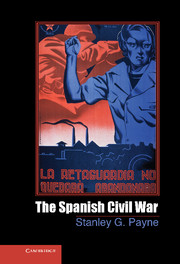Book contents
- Frontmatter
- Contents
- Chronology of Major Events
- Glossary
- Preface
- Introduction Civil War in Twentieth-Century Europe
- 1 Modernization and Conflict in Spain
- 2 From Revolutionary Insurrection to Popular Front
- 3 The Breakdown of Democracy
- 4 The Military Insurrection of the Eighteenth of July
- 5 The Battle of Madrid – the First Turning Point
- 6 Revolution
- 7 Terror
- 8 A War of Religion
- 9 Franco's Counterrevolution
- 10 Foreign Intervention and Nonintervention
- 11 Soviet Policy in Spain, 1936–1939
- 12 The Propaganda and Culture War
- 13 A Second Counterrevolution? The Power Struggle in the Republican Zone
- 14 The Decisive Northern Campaigns of 1937–1938
- 15 The War at Sea and in the Air
- 16 Civil Wars within a Civil War
- 17 The War in Perspective
- Conclusion Costs and Consequences
- Select Bibliography
- Index
Introduction - Civil War in Twentieth-Century Europe
Published online by Cambridge University Press: 05 September 2012
- Frontmatter
- Contents
- Chronology of Major Events
- Glossary
- Preface
- Introduction Civil War in Twentieth-Century Europe
- 1 Modernization and Conflict in Spain
- 2 From Revolutionary Insurrection to Popular Front
- 3 The Breakdown of Democracy
- 4 The Military Insurrection of the Eighteenth of July
- 5 The Battle of Madrid – the First Turning Point
- 6 Revolution
- 7 Terror
- 8 A War of Religion
- 9 Franco's Counterrevolution
- 10 Foreign Intervention and Nonintervention
- 11 Soviet Policy in Spain, 1936–1939
- 12 The Propaganda and Culture War
- 13 A Second Counterrevolution? The Power Struggle in the Republican Zone
- 14 The Decisive Northern Campaigns of 1937–1938
- 15 The War at Sea and in the Air
- 16 Civil Wars within a Civil War
- 17 The War in Perspective
- Conclusion Costs and Consequences
- Select Bibliography
- Index
Summary
The Spanish civil war was the most important political and military struggle in Europe during the decade prior to World War II. It not only polarized Spain, but produced an intense reaction among millions all over Europe and the Americas. The war was given many names. Leftists, as well as many liberals, termed it varyingly “fascism versus democracy,” “the people versus the oligarchy” (or “against the army”), “revolution versus counterrevolution,” and even “the future versus the past.” Rightists and conservatives at different times called it a struggle of “Christianity versus atheism,” “Western civilization against communism,” “Spain versus anti-Spain,” and “law and order against subversion.” These labels were antithetical, but nonetheless not always mutually exclusive, for the war was extremely complicated and contradictory, and there were greater or lesser amounts of truth in most of these appellations, although some were more accurate than others.
The war began over internal issues in Spain, but once all three major European dictatorships initiated limited intervention, many people began to see it as an international conflict by proxy. In other countries, attitudes were sometimes colored more by opinion about the intervening states than about the Spanish conflict itself, for the outcome was perceived by many as potentially changing the balance of power in Western Europe.
- Type
- Chapter
- Information
- The Spanish Civil War , pp. 1 - 4Publisher: Cambridge University PressPrint publication year: 2012



